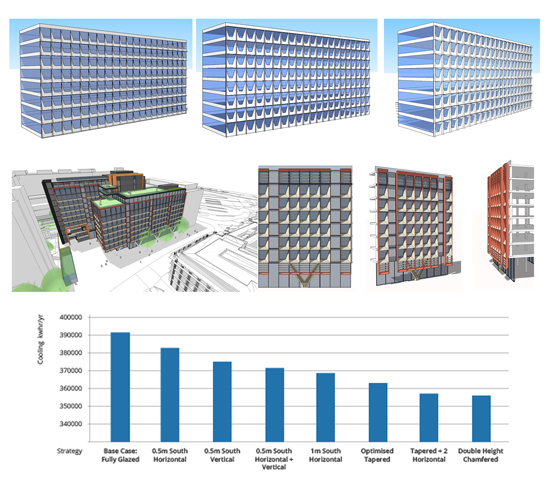Performance Matters!
Detailed Design Development and Analysis
Once the basic form of a building and the overall design strategies are determined, other specific strategies can be investigated in greater detail. Building facades are a good example of something that many architects spend a lot of detailed design attention on. In commercial buildings, the relevant building-performance issues commonly include the use of glazing to allow the admission of daylight without glare, controlling solar heat gain through treated glass and/or shading, and regulating heat transfer through opaque areas. PBD software can be used to consider alternative building-facade designs by finding the right balance between different criteria and optimizing a given facade treatment (e.g. shading devices, materiality, etc.) all by using site-specific weather data and project-specific design inputs. Further, it also allows for each facade of the building to be addressed separately so that different design solutions can be considered for each as appropriate. Altogether, this allows for optimization of the total building.
Facade Design Analysis
The design firm of Sheppard Robson uses PBD as a means to combine aesthetics and performance in innovative facade design. The design team set out to create an appropriate design aesthetic for the Bechtel House, a 322,900-square-foot office building in London. The goal for the facade was to optimize it for good energy and daylight performance while working toward high aesthetic and regulatory requirements for the project as a whole. The building mass was designed in two “blocks” with one on the north side sitting behind the one on the south side. With that basic layout determined, it came time to work out the details of refining the facade design.

Photo courtesy of Sefaira
Sheppard Robson was able to optimize the design of the building facade of the Bechtel House office building by using PBD to determine the best balance between daylight, energy use, and aesthetics.
The team started by focusing its attention on the south block, as it suffered from more solar heat gain exposure than the north block. They created simple 3-D computer model variations of the south block, starting the PBD analysis on a fully glazed base case, then testing options with reduced glazing ratios. By comparing energy use, cooling loads, and daylight levels, the team settled on an option with the optimum glazing ratio before any shading was added. Then, using real-time analysis in PBD, Sheppard Robson was able to understand the impact of different types and depths of shading systems, starting with about 20 different options. These included 0.5 meter horizontal projections, 0.5 meter vertical projections, a combination of 0.5 meter horizontal and vertical projections, and a 1.0 meter horizontal projection. Investigating even further, the team also tested a tapered vertical fin, a tapered vertical fin with double horizontal shading, and double-height chamfered panels. After reviewing and analyzing the results, the team found the most effective strategies for reducing cooling, energy use, and unwanted southern solar gains were an optimized tapered vertical fin, a tapered vertical fin plus two horizontal projections, and the double-height chamfered fins. More specifically, it found that the optimized tapered vertical shading device worked best for the north facade, and the tapered fin plus two horizontal projections was best for the south facade.

Photo courtesy of Sefaira
Different shading strategies on the facade of the Bechtel House in London were analyzed and compared for both performance and aesthetics then optimized accordingly.
Of course, all of this facade refinement also needed to take into account other design elements, such as the interior ceiling heights and the location of mechanical systems. Therefore, the design team appropriately compared the use of a traditional suspended acoustical ceiling with concealed ductwork against a chilled beam system that used an exposed soffit for its air delivery system. Sun path diagrams were then developed within the PBD model to understand how these different HVAC systems would look, interact with the facades, and affect daylight levels within the interior spaces. By comparing the impact on daylight penetration in this way, a total, coordinated understanding of the building performance could be determined in more detail. Based on this work, the design team selected the chilled beam and exposed soffit option, opening up sightlines to the sky and allowing daylight deeper into the room. It was also determined that window-sill heights that matched desk heights would not impede daylight levels or views and would provide more insulated wall area than a full glazing option. Therefore, that approach became a part of the final design as well.
Notice

www.sefaira.com

www.SketchUp.com









